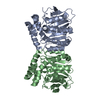+Search query
-Structure paper
| Title | Multimeric structure of a subfamily III haloalkane dehalogenase-like enzyme solved by combination of cryo-EM and x-ray crystallography. |
|---|---|
| Journal, issue, pages | Protein Sci, Vol. 32, Issue 10, Page e4751, Year 2023 |
| Publish date | Sep 29, 2023 |
 Authors Authors | Klaudia Chmelova / Tadeja Gao / Martin Polak / Andrea Schenkmayerova / Tristan I Croll / Tanvir R Shaikh / Jana Skarupova / Radka Chaloupkova / Kay Diederichs / Randy J Read / Jiri Damborsky / Jiri Novacek / Martin Marek /    |
| PubMed Abstract | Haloalkane dehalogenase (HLD) enzymes employ an S 2 nucleophilic substitution mechanism to erase halogen substituents in diverse organohalogen compounds. Subfamily I and II HLDs are well- ...Haloalkane dehalogenase (HLD) enzymes employ an S 2 nucleophilic substitution mechanism to erase halogen substituents in diverse organohalogen compounds. Subfamily I and II HLDs are well-characterized enzymes, but the mode and purpose of multimerization of subfamily III HLDs are unknown. Here we probe the structural organization of DhmeA, a subfamily III HLD-like enzyme from the archaeon Haloferax mediterranei, by combining cryo-electron microscopy (cryo-EM) and x-ray crystallography. We show that full-length wild-type DhmeA forms diverse quaternary structures, ranging from small oligomers to large supramolecular ring-like assemblies of various sizes and symmetries. We optimized sample preparation steps, enabling three-dimensional reconstructions of an oligomeric species by single-particle cryo-EM. Moreover, we engineered a crystallizable mutant (DhmeA ) that provided diffraction-quality crystals. The 3.3 Å crystal structure reveals that DhmeA forms a ring-like 20-mer structure with outer and inner diameter of ~200 and ~80 Å, respectively. An enzyme homodimer represents a basic repeating building unit of the crystallographic ring. Three assembly interfaces (dimerization, tetramerization, and multimerization) were identified to form the supramolecular ring that displays a negatively charged exterior, while its interior part harboring catalytic sites is positively charged. Localization and exposure of catalytic machineries suggest a possible processing of large negatively charged macromolecular substrates. |
 External links External links |  Protein Sci / Protein Sci /  PubMed:37574754 / PubMed:37574754 /  PubMed Central PubMed Central |
| Methods | EM (single particle) / X-ray diffraction |
| Resolution | 3.31 - 7.0 Å |
| Structure data |  EMDB-16998: Cryo-EM structure of subfamily III haloalkane dehalogenase DhmeA from Haloferax mediterranei EMDB-17015, PDB-8ooh:  PDB-8ckp: |
| Chemicals |  ChemComp-CL:  ChemComp-HOH: |
| Source |
|
 Keywords Keywords | UNKNOWN FUNCTION /  haloalkane dehalogenase-like / haloalkane dehalogenase-like /  hydrolase / hydrolase /  haloalkane dehalogenase haloalkane dehalogenase |
 Movie
Movie Controller
Controller Structure viewers
Structure viewers About Yorodumi Papers
About Yorodumi Papers






